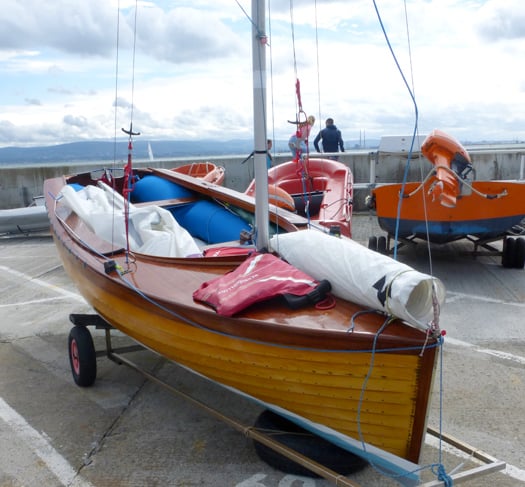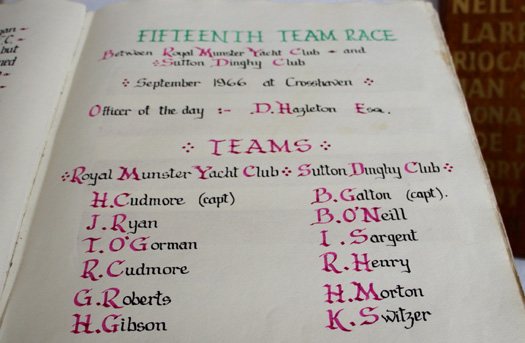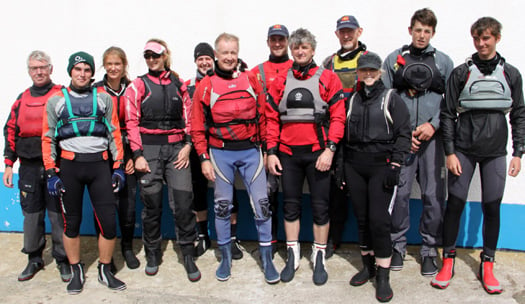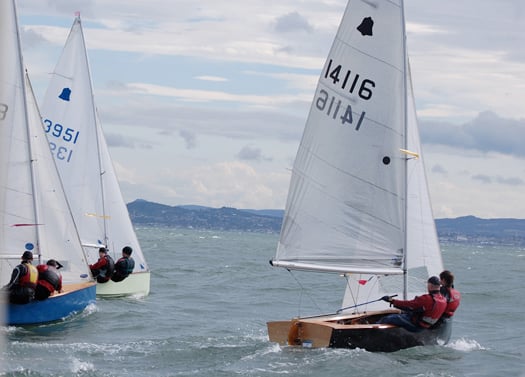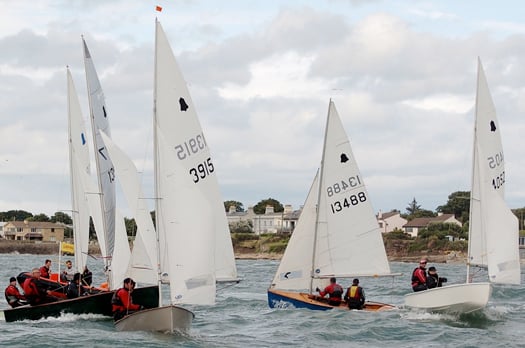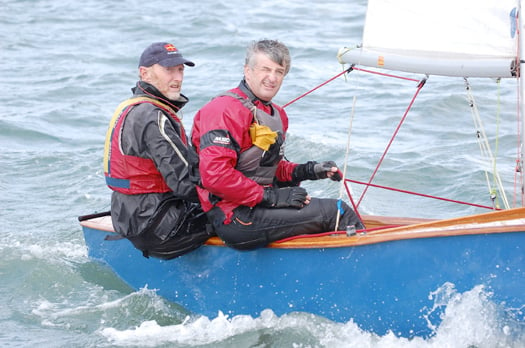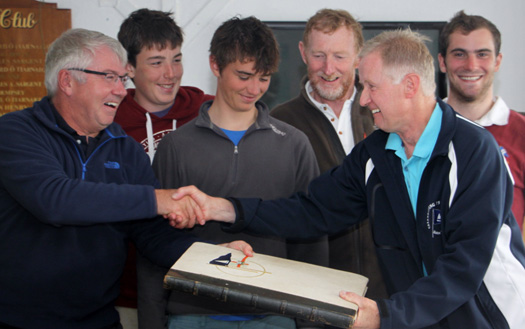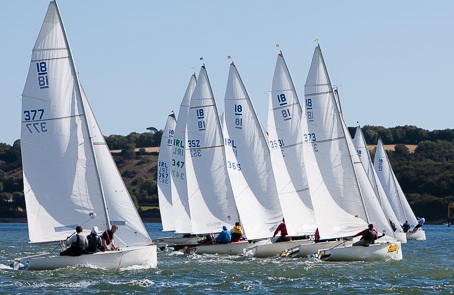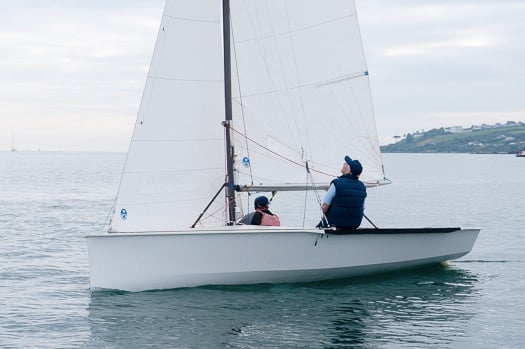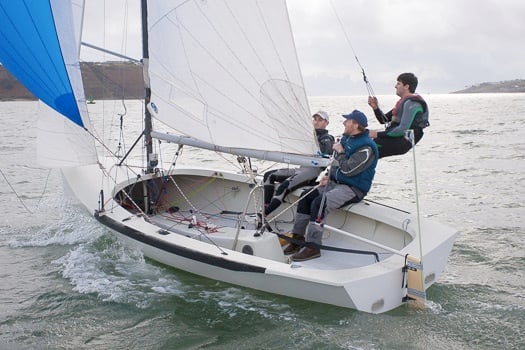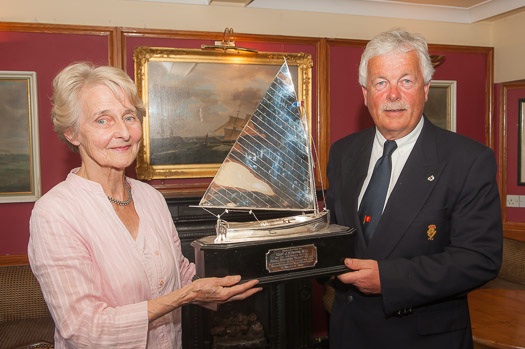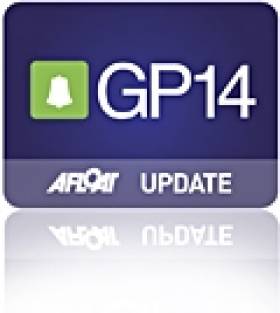Displaying items by tag: Sutton Dinghy Club
If you've ever team-raced for "The Book" between Sutton Dinghy Club and a team from Cork Harbour, then you'll know that it is Irish sailing's Book of Kells, inaugurated seventy years ago with the winning team obliged to inscribe the outcome on vellum in illuminated style. W M Nixon found that this year's event last Sunday had the Corkmen celebrating a win, even if they lost the race.
Keeping the records of sporting events may seem the simplest thing in the world, but it's amazing how quickly the written reports can disappear completely. In this blog on 12th April, we were pointing out that ancient sailing trophies are doubly valuable, as they'll still be in existence and lovingly cared for because of their intrinsic worth as pieces of silverware, and with any luck they'll also carry the name of the boats and owners, the early winners of races back in those remote mists of time.
Yet even the world's oldest original sailing trophy, the Ladies Cup of Sligo Yacht Club which dates back to 1822, took a while to cop on to the need to inscribe the names. It didn't occur until 1831, when the winner was Owen Wynne of Hazelwood on Lough Gill, that lovely lake where the Sligomen sailed before they took to the sea at Rosses Point.
Because of this understandable omission – after all, everyone who was anyone in Sligo in the 1820s would have known know who was the current holder of the Ladies Cup – the oldest sailing trophy with a winner inscribed wasn't an annual challenge cup, it was a one off, the Cork Harbour Regatta Cup for 1829. The winner was J Caulfield Beamish with his cutter Little Paddy, which he designed himself. It's a thoughtful experience to contemplate this old trophy, and realize it was once handled by one of the greatest if largely unsung pioneers of Irish sailing.
But beyond the fact of who won, we know little enough of the event in 1829. And as sailing developed down the years, a plethora of events meant that the records became confused, or else there was so much data that nobody took any notice any more.
Enter the International 12ft dinghy, a simple little lugsail rigged clinker-built classic wooden boat. She was designed by George Cockshott of Southport in Lancashire in 1912, and seems to have been an instant success with the approval of the Boat Racing Association, a sort of precursor of ISAF. Fleets sprung up anywhere that sailing took place, though the class soon faded in England where newer designs appeared in the 1920s and '30s. But today, there are thriving groups of International 12s in The Netherlands, Belgium, Italy and Japan, while in Ireland they were quite the thing until 1950.
One good reason for this was that Ireland produced an International 12 superstar, Captain Jimmy Payne of Cork Harbour, who won the World Dinghy Championship racing International 12s in Belgium in 1924, the first time the new Irish Free State had competed in a sailing event in its own right. This meant that the return series for the crews from France, Holland, England, Belgium and Italy came to race against Ireland at the Royal Munster YC in Crosshaven in 1925. This time round it went down to the last race, which Jimmy Payne won by 29 seconds from Bokre of Holland, and his prize was a truly magnificent silver model of an International 12.
The International 12s were also popular around Dublin, particularly on the north side of the Bay where they either sailed from Howth or, when the tide suited, at Sutton Creek. There was only one club on the peninsula at the time, Howth SC, which sent forth an International 12 helmed by Harry McCracken to sail in the Tailteann Games in 1932, and he won the gold medal.
With International 12 sailors of this calibre in both Cork Harbour and around the Howth peninsula, there were links between the two class centres. But it wasn't until 1940 that Sutton Dinghy Club came into being beside the tidal creek. Then in 1944 an inter-club competition was inaugurated in International 12s between SDC and the Cork Harbour Sailing Club, whose young dinghy-oriented sailors with their International 12s included several people who were later to be big achievers in major clubs.
The innovative trophy for the new series was a large vellum book, the pages blank and awaiting inscription. There may well be other inter-club sailing club competitions whose perpetual trophy is an inscribed book containing the record of each annual race, but we don't know of them. Yet the continuing existence of The Book has been so central to a golden thread of sailing in Crosshaven and Sutton that those who have been involved tend to assume that everyone else knows all about it.
The Book (senior version from 1944) and the junior (from 1980) on display at Sutton Dinghy Club for Sunday's 70th Anniversary series. Photo: W M Nixon
Perhaps they do, but this year being the 70th Anniversary, it went slightly more public anyway, with Commodore Andy Johnston and his members at Sutton DC moving mountains to make it happen in a busy season in which, every other year, the race for The Book has to be slotted into a crowded annual programme and the additional need to fit the tidal window for sailing in Sutton Creek.
Over the years, The Book has stayed the same, and it's still the same Sutton Dinghy Club, albeit in larger premises. But Cork Harbour Sailing Club – whose members had been helped in their sailing by Jimmy Payne himself, who also raced for The Book – was wound up in 1950, and its membership largely subsumed into the Royal Munster in Crosshaven, which in turn became the Royal Cork for the Quarter Millennium in 1970.
Over the years, Irish sailing classes which have seen people emerge from the testing and training ground which is the racing for 'The Book' include Olympic boats such as the Flying Dutchman and the Tempest, the famous 505s, many offshore racing fleets, Fireballs, 470s, Lasers, 1720s, SB20s, Etchells 22s, Puppeteer 22s and J/24s, to name only a few. In all, it's an extraordinary list, linked by their connection to sailors from this unique event.
The historic International 12 restored by Aidan Henry of Sutton. Photo: W M Nixon
For many years, The Book was raced for in IDRA 14s, and this restored gem shows off her elegant lines at Sutton. Photo: W M Nixon
As for the gallant little International 12s, they were shunted aside in favour of IDRA14s in 1950. But there was a sweet reminder of the little boats at the 70th anniversary event on Sunday with a beautifully restored version brought back to life by Aidan Henry of Sutton, while also there was a lovingly-maintained and historic IDRA 14. Over the years, classes used have further changed, and for a while all the Cork-based races for The Book were sailed in Enterprises, while a Junior Book inaugurated in 1980 tended to favour Mirrors.
Boats may change and people move on, but The Book has remained as an extraordinary record of personal history and sailing development. The first series in 1944 was well won by Sutton, but over the years the balance has tilted in Cork's favour with 26 wins to Sutton's 18, while there have been two draws and 23 no races resulting from some weekends of total gale and other more grisly reasons - in 1956, it was the polio epidemic.
Grim reminder of times past – the terse entry in The Book for 1956 Photo: Ron Maher
Of that first Cork team of 1944, happily the great Joe Fitzgerald is still with us, and he subsequently sailed on winning teams. As you work your way through the handsome big pages, the names cascade down the years, so much so that just about every sailor of significance from Cork Harbour or Sutton (and sometimes Dublin Bay generally) has been racing for The Book.
The teams and Race Officers at Sutton in 1944 – Joe Fitzgerald of Cork is third from the right in the front row.
Royal Cork won in 1966 with a stellar team
Sutton's Ian Sargent and Royal Cork captain Harold Cudmore with The Book and their teams in 1966
These days, the Sutton sailors favour GP 14s, while for many years now the National 18s have been the heart and soul of Crosshaven sailing. This is so much the case that last year the Crosshaven class produced a fine book by Brian Wolfe not just of its history in Cork Harbour since 1939, but about the story of the National 18 at all its class centres through England, Wales, Scotland, Ireland and the Isle of Man.
Both the GP 14s at Sutton and the National 18s at Crosshaven are having a busy season throughout 2014. But it was noticed that while the cream of the Crosshaven class would be at the British & Irish National 18 Championship in Abersoch in North Wales from July 28th to August 1st, the top GP 14s at Sutton would not be heading away for their Worlds at East Down YC on Strangford Lough until Friday August 8th. There was a tiny window of opportunity on Bank Holiday Sunday, August 3rd, when the paths might be made to cross and the tide suited in late afternoon. So they grabbed it, and Sutton Dinghy Club readied up six evenly-matched GP 14s in a very focused frame of mind, as they hadn't won The Book in sixteen years.
These National 18 sailors from Crosshaven certainly are keen. Despite having raced a gruelling week in Abersoch with the National 18s, Tom Crosbie, Barry O'Meara and Tom Dwyer were ready and willing to race GP 14s for The Book just a day later. Photo: W M Nixon
The two teams for the 70th Anniversary of racing for The Book – Tom Crosbie (left) is Cork captain, while Hugh Gill (centre) captained Sutton. Photo: Ron Maher
At first, conditions looked reasonably promising, but fast moving clouds south and north.............Photo: Andy Johnston
....gave every indication of stronger winds to come. Photo: Andy Johnston
Downsizing from an 18-footer to a 14-footer was gallantly accepted by Cork crew Tom Dwyer and Barry O'Meara. Photo: Andy Johnston
After a week of hard racing off Abersoch, the Corkmen could have been forgiven for wishing only to head on home for a rest, but they're great sportsmen, they were determined to give it their best shot. However, for people down-sizing from a three man 18 footer to a two man 14 footer just for one afternoon's team racing, the conditions were cruel, with a squally west to southwest wind, and a fast-changing sky which promised more to come.
It duly delivered. They managed the first race with the teams even at first, but then Hugh Gill of Sutton sailed Patrick Crosbie of Crosshaven away from his lead over the next Sutton boat, and that changed the table just enough to have Sutton ahead by one point after one race. And that was the end of it. The wind rose well up into the 30 knot zone, there were four capsizes and one dismasting, and The Book for its 70th Anniversary went to Sutton Dinghy Club after a gap of sixteen years.
Tom Crosbie (left) returns The Book to Sutton's Hugh Gill after a 16-year run. But next year's racing will be in Cork in National 18s......Photo: Ron Maher
Yet everyone was delighted with the day. While the team racing tactics may have been cut-throat, the sport was great, and you could have run a string of bright lights off the camaraderie, with Dommo Long, the father of the National 18s, still much involved, although it's a report in The Book from very long ago which records how he kept all Sutton entranced with the post race party until six o'clock in the morning.
The National 18s as they are today. Photo: Bob Bateman
Testing the water. Father of the Class Dommo Long has an approving trial sail on the new National 18 last Autumn. Photo: Bob Bateman
Next year, of course, it will be an away match for the Sutton crews. And who knows, but they may be able to race in the brand new National 18s, a Cork-inspired concept which has been coming along very nicely, and is set to become Ireland's hottest "new" class in 2015, which goes some way to explain why the Cork men arrived in Sutton in such good form.
We ran a story in Afloat.ie about the Phil Morrison-designed prototype sailing at Crosshaven last Autumn, the boat having been cleverly developed through outside sponsorship so the €65,000 development cost didn't make a dent in the class funds. But a prototype is one thing, getting it accepted by the class association and into production is something else altogether, and everything would hinge on how the mood went at the championship in Abersoch, which would also see the crucial AGM.
Afloat, everything went fine for the Corkmen. Stuart Urquhart of the Scottish fleet may have had a good lead in the early stages, but by the finish the 2014 Champion was Ewen Barry of Cork crewed by Dion Barrett and Stan Browne. In runner up place was another Cork helm, Colin Chapman (who has played a leading role in the moves towards the new design), crewed by Bobby Bearla and Morgan O'Sullivan, while initial leader Urquhart was back in third.
The new Odyssey National 18 looks the business for speed..... Photo: Bob Bateman
......and she retains the basic seamanlike features of the established National 18s. Photo: Bob Bateman
The new boat Odyssey was out sailing and showing fabulous performance, so minds were concentrated mightily for the main formal business which came on Thursday July 31st, the 2014 AGM and the acceptance or otherwise of the new design. The National 18 is a restricted class, so in theory any new design which complies with the rules should be accepted. But the days are long gone when cheque-book sailing affected the class – if it ever did – so a significant majority would be needed to be in line with the spirit of the class, which has always favoured design development, but at a measured pace.
The vote was better than a significant majority – it was overwhelmingly in favour. Exciting times lie ahead, and no more so than in Cork. Twelve deposits have already been put down on new boats to the Odyssey design, and eight of those have come from the Cork Harbour fleet.
There's no doubt the new Morrison boat is a gorgeous bit of kit which is a delight to sail, and if you doubt this, I've been told to say that Dommo Long says so. Already, the class is rejuvenating around Cork Harbour, and though there are bound to be growing pains, you need to experience the sheer joy in sailing and the camaraderie of a handsome big three-man boat to understand the extraordinary sense of community which the National 18s engender in the special RCYC context.
In the final analysis, these people are sportsmen who sail for fun, and their dedication and enthusiasm is a joy to behold. They're respectful of the past, yet excited about the future. And the spirit of Jimmy Payne and the International 12s lives on, not least in the fact that the supreme overall prize for the National 18s in Cork Harbour is now the silver International 12 trophy which he won back in 1925.
In 2011, Mrs Eithne Payne presented the International 12 trophy, won by her father-in-law Captain Jimmy Payne in 1925, to RCYC Admiral Peter Deasy to become the season-long overall winner prize for the National 18 Class on Cork Harbour. Photo: Bob Bateman
#YouthSailing - US sailor Morgan Reeser gave an inspiring talk to over 50 young sailors, their instructors and a few parents at Sutton Dinghy Club on Thursday 3 July, writes Andrew Johnston.
Reeser's son Nicolas has been a regular attendee at courses in Sutton the last two summers while on holiday in the locality, and this week has been sailing in Sutton Creek with his father and some of the other trainees.
Morgan Reeser, a 470 Olympic silver medallist in Barcelona 1992, is currently coaching both the US and Austrian Olympic 470 hopefuls and successfully coached the Greek 470 women's team to Olympic gold in Athens 2004 and the British 470 men to Olympic silver in Weymouth during London 2012.
He talked to the juniors about his first 'start sailing' course in Miami in an Optimist, as well as some of his sailing heroes and the coaches that inspired him.
Reeser also remembered his first visit to Dublin in 1981 for an inter-country team racing event sailed in Shamrock half-tonners in Dun Laoghaire, and obviously about his preparation for the Olympics in Barcelona in 1992.
His abiding memory of the final race of the regatta, after finishing in a tight bunch, was that he and his crew Kevin Burnham didn't find out till they reached the marina 40 mins later that they had won a medal.
He outlined the fine margins between medaling and missing out at events, explaining they would have been out of the medals altogether if they had dropped a single place in their best race at the regatta, which happened to be a race win.
Reeser was back at the Olympics in Atlanta in 1996 and while he failed to take a medal, he met his future wife, none other than Irish Olympic 470 sailor Louise Cole.
The winning of an Olympic medal is obviously a fantastic memory for Reeser, but one of his best memories is of the opening ceremony in Barcelona and the opportunity to meet up with top-class athletes from around the world.
Since turning to coaching, Reeser has encouraged his Olympic hopefuls to attend the opening ceremony as this is one of the things that make it the 'Games' and not just another regatta.
Sutton Dinghy Club Commodore Andy Johnston presented Reeser with a club burgee and thanked him for taking the time drop in and talk with the club's young sailors and their instructors.
Before getting back on the water, many of the kids availed of the opportunity to get the autograph of a fully fledged Olympic medalist on what was a memorable morning for the young sailors and indeed for all in attendance.
#mirror – The 2014 Mirror dinghy Eastern Championships were completed on Sunday in superb racing conditions at Sutton Dinghy Club with victory for local pairing Robert Dickson and Meisha Johnston.
With Junior and Leaving Cert exams coming shortly a smaller than expected fleet of 11 Mirrors arrived in Sutton for the second regional event of the season. While the field was small it included rising Sutton talent Shane McLoughlin and Conor Twohig, current National Champion Cian Hickey from Skerries as well as top Irish Mirror sailors Tiernan Dickson (L Ree) and Jack Maye (Sligo). With local sailor Sinead Dickson preparing for exams, brother Robert teamed up with her young crew Meisha Johnston.
The fleet launched in gusty 15-20kts conditions late Saturday morning and PRO Richard Kissane got 3 great races completed in the Dublin Bay in windy and lumpy conditions.
In Race 1, Mcloughlin/Langan took a very close race from Hickey/Hickey with T.Dickson/Leech in 3rd. Race 2 saw R.Dickson/Johnston get into their stride and eventually take the gun in a close finish from Club mate McLoughlin/Langan with Sligo's Maye/White in 3rd.
In the final race of the day locals Twohig/Gibney had a super start and led for 3 legs holding off R.Dickson/Johnston and Hickey/Hickey. A broken main-sheet block on the second last leg allowed Dickson/Johnston the chance to ease themselves in front. Twohig/Gibney did ever so well to hold off the Hickey brothers from Skerries and take a superb 2nd.
On Sunday with a later tide and 15kts mainly from the South, PRO Richard Kissane had to shift the courses a number of times over the day as the wind shifted left and right throughout the afternoon.
With the gybe mark right in under Red Rock, Howth the fleet had an ongoing audience up close on the cliff walk throughout the afternoon. With 4 boats within 3 points at the start of the day and only a quarter of a point between Dickson/Johnston in 1st and McLoughlin/Langan 2nd the first race was always going to be a marker for the rest of the day.
In Race 4, Mcloughlin/Langan got a super start and developed a substantial lead. But Robert Dickson, the recently crowned 420 National Champion was never going to let the lead boat have it all there own way. Leg after leg Dickson/Johnston gradually worked there way back up till they were no more than a boat length behind at the final leeward mark. On the line Mcloughlin/Langan held off the challenge only to discover they had been OCS. Despite the disappointment, this was a superb race from McLoughlin/Langan pairing. The minor places went to Maye/White (Sligo YC) and Hickey/Hickey (SkerriesSC).
Race 5 continued where the earlier races had left off with McLoughlin/Langan never far from Dickson/Johnston. These 2 boats kept ahead of a tight tussle between Sligos Jack Maye and Skerries Cian Hickey. In the end the Dickson/Johnston team put some distance between themselves and fellow Club mates McLoughlin/Langan to take a second victory on the day. Jack Maye took 3rd and fast finishing and former event winner Tiarnan Dickson from Lough Ree took 4th from Cian Hickey.
With 4 race wins from 5, any finish bar a disqualification in the 6th and last race and Dickson/Johnston would be assured of victory. The chase for runner up spot was still very much on between former event winner Cian Hickey and Shane McLoughlin from the host Club. The final race of the day saw the top 5 or 6 boats battle it out in by now a very steady 15kts. By the gybe mark it was Dickson/Johnston who held the lead closely followed by McLoughlin/Langan. The chasing pack could make no inroads into the leading pair on the concluding legs which meant victory for Robert Dickson and his young crew Meisha Johnston. Shane McLoughlin and his crew Oscar Langan held off the fast chasing National Champion Cian Hickey to take a well deserved 2nd place in this the second regional event of the season.
The leading Silver fleet boat in the series in only their second event were Samuel & Imogen Wray from Sligo YC. The next event is the Mirror Northern Championship in Royal North of Ireland YC, Cultra on June 21st.
Place Helm/Crew Club
1 R.Dickson/M.JohnstonSDC
2 S.McLoughlin/O.LanganSDC
3 C.Hickey/E.HickeySSC
4 J.Maye/M.WhiteSYC
5 T.Dickson/A.LeechLRYC
6 C.Twohig/J.GibneySDC
7 S.Wray/I.WraySYC
8 C.Croasdel/O.McAllisterLRYC
9 R.McAllister/L.CroasdelSchull Harbour
10 S.Kelly/A.HarperSDC
11 S.Nicholson/M.MartinSYC
Strengthen Fingal's Freedom for the Good of Irish Sailing
#fingal – The Government's recent move to create a framework for the direct election of a new all-powerful Mayor for Dublin was expected to be a shoo-in. The new Super-Mayor's authority would incorporate the current four local councils of Dun Laoghaire-Rathdown, South Dublin, Dublin City, and Fingal, each one of which had to vote in favour. But Fingal's councillors voted firmly against it, despite emphatic support of the proposal by the councillors in the other three areas. As a Fingallion by adoption, W M Nixon strongly supports this independent move by a largely rural and coastal region which has a longer shoreline than all the other Dublin areas put together, and is clearly not a naturally integral part of the city.
Fingal is the Ukraine of Leinster, and the glowering monster of Dublin is the Russia within Ireland, intent on the conquest of its smaller freedom-seeking neighbour. Vigorous, all-powerful, intensely urban, and distinctly impressed with itself, Dublin is certain that the further its bounds are spread, the better it will be for all its citizens. And the more citizens it can claim, then the better for Dublin.
But Fingal is different. For sure, it can seem a bit sleepy and rural by comparison with central Dublin, but that's the way we like it. It's a place of odd little ports and much fishing, a region of offshore islands, rocky coasts and many beaches on one side, and the profound heart of the fertile country on the other. A place where – as you move north within it - you might make a living in many ways at once, taking in growing vegetables, raising animals, running a dairy herd, and keeping a lobster boat down at the local quay, while perhaps having a horse or two as well. And if you feel like more shore sport, the golfing options are truly world class.
As for the sailing and all other forms of recreational boating, Fingal is not just a place of remarkable variety – it's a universe. With five islands – six if you count Rockabill – its 88 kilometre coastline is one for sport, relaxation and exploration. Sea angling is well up the agenda, and it's a kayakers' paradise, while Irish speed records in sailboarding and kite-surfing have been established in the natural sand-girt canal which forms for much of the tidal cycle in the outer Baldoyle estuary immediately west of Howth.
Apart from fishing boats – and inshore they're usually only the smaller ones – it has no commercial traffic. And though there are tidal streams, in southern Fingal's main racing area between Ireland's Eye and Lambay, they're not excessively strong, and run in a reasonably clear-defined way, while the flukey winds which so often bedevil Dublin Bay away to the south are much less of a problem in sailing off Fingal, where the winds blow free.
The range of boat and sailing clubs of Fingal matches the variety of its coast. The most southerly is Sutton Dinghy Club, rare among Ireland's yacht clubs in being south-facing. It may be focused on sailing in Dublin Bay, but scratch any SDC sailor, and you'll find a Fingallion. Round the corner of the Baily – not a headland to be trifled with - Howth has two clubs, the yacht club with its own marina, and Cumann na Bhad Binn Eadair (the Howth Sailing & Boat Club) in the northeast corner of the harbour, while Howth Sea Angling Club with its large premises on the West Pier is one of the tops in the country.

The sunny south. Sutton Dinghy Club is Fingal's most southerly sailing club, and is also rare in Ireland through being south facing.
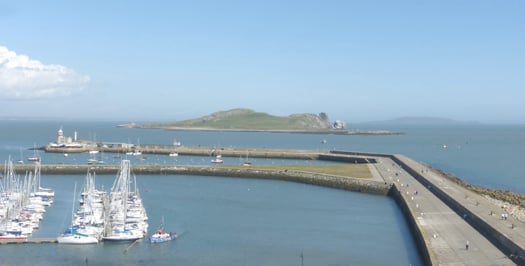
Islands of Fingal seen across the eastern part of Howth marina, with Ireland's Eye in the foreground, and Lambay beyond. Photo: W M Nixon
As for the waters they share, their most immediate neighbour is the steep island of Ireland's Eye with its pleasant southwest-facing beach, the island itself a remarkable wild nesting site, particularly when you remember that it's close beside an intensely urban setting. When a discerning visitor described Ireland's Eye as "an astonishing and perfect miniature St Kilda", he wasn't exaggerating.
Across in Malahide, where we find Fingal's other marina, Malahide YC - which recently celebrated its Golden Jubilee and currently has Graham Smith as its first second-generation Commodore – is in the curious position of having two clubhouses. One is a charming and hospitable place among trees within easy stroll of the marina, while the other is west of the long railway embankment which retains the extensive inner waters of Broadmeadow. This makes the waters into a marvellous recreational amenity and boating and sailing nursery, so not surprisingly it is home to active sailing schools. And it is also the base of Malahide YC "west", a dinghy sailing club on the Broadmeadow shore at Yellow Walls, while further west of it again is yet another club, the more recently formed Swords Sailing & Boating Club.

The map of modern Fingal shows how the southwest corner of the present region seems remote from the largely coastal and rural nature of much of the rest of the county. And it also confirms the surprise (to many) that the Phoenix Park is in Fingal.
North from Malahide, and you're into "Fingal profonde", its deeply rural nature occasionally emphasised by the sea nearby. The long Rogerstown Estuary, the next inlet after Malahide, sometimes found itself providing the northern boundary of The Pale, and as recently as the early 1800s the river at Rogerstown and the tiny port of Rush were a veritable nest of smugglers, privateers and occasionally pirates, with buccaneering captains of myth and legend such as Luke Ryan and James Mathews proving to have been real people who were pillars of society when back home in their secretive little communities after their lengthy business forays to God know where.

Muddy situation. Low water in the Rogerstown Estuary. The hill in the distance on the left is new – for years, it was the largest dump in Ireland, the Balleally Landfill. But now it is well on its way to rehabilitation as an enhancement of the landscape. Photo: W M Nixon
The Rogerstown Estuary went through an unpleasant period when its inner waters were dominated by the nearby presence of the biggest waste dump in Dublin, Balleally Landfill. It rose and rose, but now it's closed, and is in process of being revived to some sort of natural state. The result is that the vista westward from Rogerstown is much improved by a pleasant and completely new hill which so enhances the view at sunset that shrewd locals have built themselves a row of fine new houses facing west, along the quirkily named Spout Lane which runs inland from the estuary.
Whatever about the legality-pushing privateer skippers who used Rogerstown Estuary as their base in days of yore, these days it's home to the quay and storehouse which serves the ferry to Lambay, which is Fingal's only inhabited island when there are no bird wardens resident on Rockabill, and it's also the setting for another south-facing club, Rush SC. It is spiritual home these days to the historic 17ft Mermaid Class (they still occasionally build new ones in an old mill nearby), but despite the very strong tidal streams where the estuary narrows as it meets the sea, RSC also has a large cruiser fleet whose moorings are so tide-rode that unless there's a boat on the buoy, it tends to disappear under water in the final urge of the flood. This can make things distinctly interesting for strangers arriving in and hoping to borrow a mooring while avoiding getting fouled in those moorings already submerged. Not surprisingly, with their boat sizes becoming larger like everywhere else, Rush SC find that their bigger cruisers use Malahide Marina.
To seaward of Rogerstown, with the little port of Rush just round the corner, the view is dominated by Lambay. A fine big island with is own little "miniature Dun Laoghaire" to provide a harbour on its west side, it has a notable Lutyens house set among the trees. But for many years now Lambay has been a major Nature Reserve, so landing is banned, though anchorage is available in its three or four bays provided you don't interfere with the wildlife along the shore. This makes it off bounds to kayakers who might hope for a leg stretch on land, though it's still well worth paddling round close inshore.
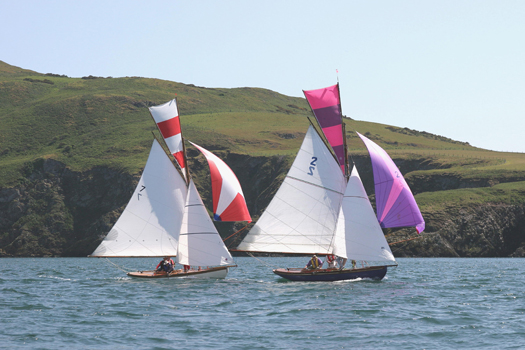
Racing round Lambay. Close competition between the Howth 17s Aura (left) and Pauline, which have been racing annually round Lambay since 1904. Photo: John Deane
Along the Fingal mainland coast, the next inlet after Rush is Loughshinny, a lovely natural harbour with a quay to further improve the bay's shelter. There's a very active little fishing fleet, while the shoreside architecture is, how shall we say, decidedly eclectic and individualistic? Go there and you'll see what I mean.
Six miles offshore, Rockabill marks the northeast limits of Fingal. It's a fine big double-rock, with a substantial lighthouse and characterful keepers' houses attached. But as it's now automated, the only time Rockabill is inhabited is for the four summer months when a bird warden or two take up residence to monitor the rocky island's most distinguished summer residents, Europe's largest breeding colony of roseate terns.
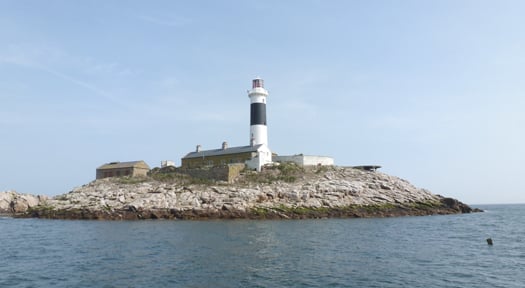
Rockabill, where the shy roseate terns feel at home. Photo: W M Nixon
In Fingal we tend to take these pretty but noisy summer visitors for granted, but the word is that south of Dublin Bay the tern buffs are so incensed by Rockabill having a clear run that they're tried to start a rival colony of roseate terns on the Muglins, and built a row of tern houses (one good tern deserves another) to facilitate their residence. The potential nest sites may not have survived the past severe winter. But in any case, one wonders if they had planning permission from Dun Laoghaire/Rathdown council for this development? Persons suggesting that such a development would almost certainly be terned down will not be given any attention whatsoever.
Skerries and Balbriggan are the two main sea towns of north Fingal, and they're as different as can be, the difference being emphasised by historic rivalry. It's said that back in the government harbour-building days of the late 19th Century a grant was made available to assist local landowners to make significant improvements to one of the harbours, and this meant war.

Balbriggan may very definitely dry out, but it provides a secure home port for both trawlers and other boats prepared to settle on the mud and sand. Photo: W M Nixon
So eventually the grant was split with half going to improve Balbriggan, and the other half to Skerries, with neither being a total success. If you seek total shelter in either today, you have to be prepared to dry out, while the anchorage off Skerries is also subject to a large tidal whorl which means that when the ebb is running in a strong onshore wind, the moorings are doubly rough and diabolically uncomfortable. And every so often after an exceptional nor'easter, we have another litany of boats driven ashore and Skerries yacht insurance going even further through the roof.
It's a situation which needs proper attention from an administration which is genuinely interested in the port. And the proper development of the harbour at Skerries, while retaining the little old place's special character, is surely something which could be much better done by Fingal Council rather than some remote Mayor of Dublin for whom Skerries will be the outermost periphery, a place seldom visited, if at all.
We've seen it all before. Time was when Fingal was simply the North County, little noticed in the centres of power which were basically Dublin City and Dublin County, their head offices in the heart of the city. But then in 2001 the new four-council setup was created, and the old name of Fingal – never forgotten by those who cherished the area – was revived. A very fine new user-friendly County Hall – it has even been praised by Frank McDonald of The Irish Times – was built in the re-born county town of Swords. Out on the new boundaries meanwhile, the signs went up saying "Welcome to Fingal County". But we old Fingallion fogeys pointed out that as Fingal means "Territory of the Fair Strangers" (i.e the Norsemen rather than the Danes), it was superfluous to be describing it as "the county of the territory", so these days it's just Fingal, and we're happy with that.
Here in Howth, we sort of slipped into acceptance of the new setup. Once upon a time, from 1917 to 1943, Howth had its own Urban District Council. It says much for the place's remoteness from the world that the HUDC was established in the midst of one global war, and quietly wound up in the midst of another. In 1943, Commissioners had to be imposed on the tiny fiefdom to offset the fact that some local interests thought the HUDC existed entirely for their own personal benefit. So at various times since, Howth was run either by Dublin County Council, or even by Dublin City Corporation. We were assured that this latter setup was all to our benefit, as the powers-that-be in City Hall had a soft spot for Howth, sure wasn't it the place where the mammy went every Thursday evening to buy the family's fish, and wouldn't she want to see it looking well?
Maybe so, but when it came to doing something more useful with the harbour, Howth Yacht Club – having re-constituted itself in 1968 from an amalgamation of Howth Sailing Club (founded 1895) and Howth Motor Yacht Club (founded 1934) - found itself dealing with a bewildering variety of government departments as the lowly interests of fishing and its ports seemed to be shifted whenever possible by civil servants who reckoned that banging the drum on behalf of fisheries in particular, and maritime interests in general, was not a shrewd career move for anyone planning a steady progress up the very landbound Irish public service ladder to the sunlit uplands of a long and prosperous retirement.
So if at times absolutely nothing seemed to be happening in a harbour which was painfully inadequate for expanding boating and fishing needs, it was partly because the club officers and fishermen's leaders could find it difficult to discern just who in authority could or would make the decisive call. In those days it turned out to be somewhere in the hidden recesses of the Office of Public Works. Suddenly, in 1979, a plan for the major re-development of the harbour was promulgated at official level, with a radical rationalisation planned for its future use. The western part, it was proposed, would become totally fisheries, while the eastern part was to be given over to recreational boating, all of it involving major civil engineering and harbour works projects.
Looking at the successful harbour today, it all seems perfectly reasonable and sensible. But back in 1979 when HYC were presented with a time-limited take-it-or-leave-it choice, the way ahead was not at all clear. Friendships were sundered and family feuds emerged from the heated progress towards accepting the offer that the club agree to vacate its premises on the West Pier - a clubhouse which it had renovated and extended only ten years earlier – and commit itself to the installation, at members' cost, of a marina in the eastern harbour with the obligation to build a completely new clubhouse there.

Today's Howth Harbour didn't happen overnight. This is how it was from 1982 until the new clubhouse was completed in 1987. Photo: W M Nixon
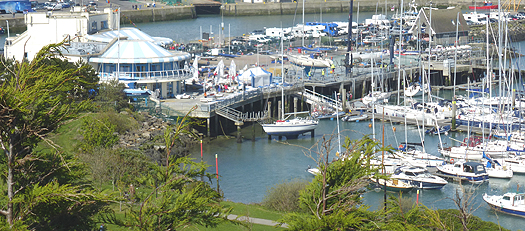
Multiple activities under way at Howth YC this week. The club's setup may seem only natural now, but it was quite a struggle to get there. Photo: W M Nixon
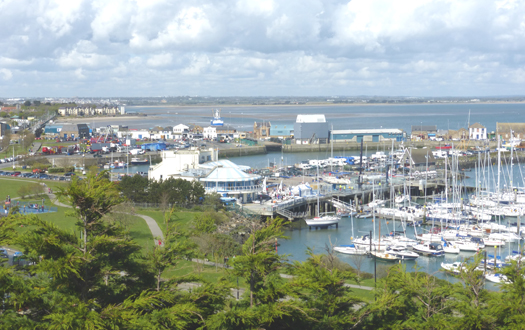
Howth's vibrant mix of a working fishing port and busy sailing centre has provided the ideal setting for the development of a successful visitor and seafood destination. Photo: W M Nixon
It's all history now, but it was done. And done so well by those involved that today it's simply taken for granted. Arguably, it's a compliment to those who created the Howth YC setup, that newer members should seldom wonder how it all came to happen, it just seems so right and natural. And as for those running the club, they in turn have to build on past achievements in dealing with an ever-changing administrative environment in which the changeover to being part of Fingal was only one of several evolutions.
Yet the recent attempt to abolish Fingal was a wake-up call. In Howth we may have wandered into it, but in just a dozen years, a dormant Fingal identity has come quietly but strongly awake. In Howth village it's natural enough, as our backs are turned to Dublin and we look to the rest of Fingal. But even on the south side of the hill, where fine houses face across Dublin Bay and you'd expect a sense of identity with households in similarly choice locations for all that they look north out of Dun Laoghaire, you find that the attraction of visiting the southside has the exotic appeal of going foreign, while those of us more humbly placed in the village, if visiting remote places like Rathmines or Terenure, find it positively unnerving to think of all the houses between us and the sea.
Then too, while Fingal Council has been establishing itself in our hearts and minds, it has been a good time for Howth Harbour. Good fences have been making good neighbours, and though marine administration in government has been kicked from pillar to post, an underlying Department of Fisheries recognition that their harbours cannot be only about fishing has led to a re-think on the use of buildings about the harbour, with Howth becoming an extraordinary nexus of good seafood restaurants, such that on a summer evening, despite the presence of a traditional fish and chip shop, the seafood aroma is of a proper fishing port in Brittany or Galicia. In fact, rents from the hospitality and sailing and marine industries in Howth have now reached such a level that fish landing fees – formerly the bedrock of the harbour economy – only contribute about 10% of the overall income.

The man from County Hall. Fingal Mayor Kieran Dennison is comfortable with his county's busy sailing activities, and the sailors are comfortable with him. He is seen here officially opening the J/24 Worlds at Howth in August 2013. Photo: W M Nixon
As for how we've been getting on with our new masters in County Hall up in Swords, the news is good. Most recently, we've been having direct contact with the current Mayor of Fingal, Kieran Dennison, who hit just the right note when he officially opened the J/24 Worlds in Howth in August 2013. Following that, he was back at the annual Commodore's Lunch in HYC in the dark days of November when a review of the past season lightens the onset of winter, and he was able to tell us that thanks to contacts made at the Worlds, his invitation to visit the America's Cup in San Francisco in September was made even more enjoyable. Those of us who reckoned the only way to visit the 34th America's Cup was on the television screen were reassured by the thought that if somebody was going to represent us in the San Francisco bear-pit, then our Mayor, our very own Mayor of Fingal, was just the man for the job.
So we very much want to keep Fingal in existence and in robust good health, but we appreciate that its current boundaries might be creating a bit of a Ukraine-versus-Russia situation. In particular, the southwest of the county could well be Fingal's Crimea and Donetsk regions. There, relatively new settlements of ethnic Dubs in places like Clonsilla, Castleknock, Blanchardstown could become such a source of trouble that it might be better to transfer them peacefully to administration by either Dublin city or South Dublin before there is unnecessary bloodshed.
The situation arises because, when the boundaries were being drawn, southwest Fingal was set out all the way down to the Liffey. The Fingallion instinct would be to see the border drawn along the Tolka, in other words the M3. But there could be trouble because of the discovery – always something of a surprise – that the Phoenix Park is in Fingal. I could see that when some people find our Fingal includes the Park, they'll want to fight for it, particularly as, in the southeast of the county, the excellent St Anne's Park in Raheny was somehow allowed to slip into Dublin City.
One thing which is definitely not for transfer is the Airport. It is naturally, utterly and totally part of Fingal. For sure, it contributes a fifth of the county's annual income from business rates, making Fingal the economically healthiest Irish county. But we in Fingal have to live with the airport very much in our midst. If Dublin really wants to take over the airport, then a first condition before negotiations even begin would be that all flight paths are to be re-routed directly over Dun Laoghaire and Dalkey. A few weeks of that would soon soften their cough.
Whatever, the recent kerfuffle about Fingal rejecting involvement in administration by an all-powerful Mayor of Dublin has been a powerful stimulant to thinking about how our own county might best be run. Everyone will have their own pet local projects, and most of us will reckon that decision-making in Swords, rather than in some vast and impenetrable office in the middle of Dublin, will be the best way to bring it about. For those of us who go afloat, the fact that Fingal Council shows that it cherishes its long and varied sea coast, rather than preferring to ignore it, is very encouraging. And the fact that this prospering county has some financial muscle all of its own gives us hope that we can build on what the past has taught us, and spread improved facilities to every port. Should that happen, it will in turn benefit Irish sailing and boating generally to a greater extent than would restricted development under one closely-controlled central administration headed by some southside megalomaniac.
GP14 Nationals Hosts And Sailors Raise Thousands For Make-A-Wish
#GP14 - A fundraising effort at the recent Craftinsure GP14 Championship of Ireland has helped raise more than €4,000 for Make-A-Wish Ireland.
Last Thursday 14 November a cheque for €4,218 was presented to the charity's representative Martina Madden by Sutton Dinghy Club Commodore Andy Johnston at a special evening to thank the club's sponsors and partners.
The donation represents the efforts of competing sailors, their families, visitors and club members alike at the three-day GP14 class competition hosted by Sutton at the end of August, which attracted 50 boats and crews from across Ireland and the UK.
As previously reported on Afloat.ie, three-time Irish Olympic sailor Ger Owens and crew Melanie Morris took the event in style amid some exceptionally close competition.
Presenting the cheque, Cmdr Johnston thanked event organiser Hugh Gill and his team for the huge effort in not only staging a successful sailing event but also supporting such a deserving cause as Make-A-Wish Ireland.
Madden, meanwhile, thanked the club and the GP14 Class Association for their decision to select Make-A-Wish Ireland as the events charity of choice and applauded the efforts of sailors, volunteers, members and sponsors in helping raise such a fantastic amount for a worthy cause.
The evening was also attended by Stephen Boyle, representing the GP14 Class Association, and Ciaran Murphy of the ISA, along with representatives of some of the club's sponsors.
Owens & Morris Confirm Irish GP14 Title at Sutton Dinghy Club
#gp14 – The final day of 2013 Craftinsure GP14 Championship of Ireland and the forecast was not good for racing. 3 knots gusting 4 is not conducive to getting in 2 races. With the day looking like it would be warm with plenty of sun, the hope was a sea breeze would kick in.
Event leader Ger Owens and Melanie Morris really needed only a top 10 finish in one race to confirm the title but it was all to play for the minor placings and the Silver, Bronze and Classic fleets.
The race management team on committee boat Saoirse headed out to the bay and wasn't long before they called for fleet to launch. The 2pm start was AP'd but it wasn't long before breeze shifted more easterly and PRO Scorie Walls had the fleet in sequence. Windward leeward course and Black flags. The fleet get away all clear.
On first beat, fleet splits equally left and right. Wind was now steady about 110 and 8 knots. At the weather mark it wasclose with McCarthy (14061), Owens (14076), Morris (14077) and Corcoran (14047) all to the fore. Fleet splits again with Morris (14077) ahead of Owens (14076) pink spinnaker staying right on Red Rock side of the course. Corcoran (14047) and Gill (13915) come left and out into the bay.
At halfway down the leg, O'Connell (13801) is now also in the mix along with McCarthy (14961), Elmes (13982) and O'Tiarnaigh (14116X). By the leeward mark Owens O'Connell and Morris are leading 3 and have a few boat lengths on the chasing fleet. Most of the fleet stay out right for a bit before tacking back across to the Sutton shore.
At this point Owens just needs to maintain his position and the title is his but its turning into a repeat of yesterdays last race battle between O'Connell and Owens. Both boats were neck and neck, tack for tack down to weather mark with Owens just creeping inside O'Connell at the mark. A great rounding and then super hoist sees Owens come out that little bit quicker and the momentum was now with the event leader.
Corcoran has now connected with Owens and O'Connell and these 3 are ahead of the fleet. The battle behind was equally close with Elmes, McCarthy, Morris all very tight but the race was between Owens out right and Corcoran and O'Connell as they headed down to leeward mark for the last time.
Around the mark and Owens has the advantage and comes home first and 5 races on the bounce and the new GP14 Champion. Its very close but Corcoran pips O'Connell for 2nd with Morris 4th ahead of Elmes and McCarthy 7th.
In Classic fleet veteran Pat Murphy/Ronan Hand had a race win from local junior Callum Maher/Saoirse Kelly. In Silver fleet, David Lappin (Skerries) and Bill Johnson (Lough Foyle) were still battling it out and the BronE fleet would also go to the last race with a point separating local junior David Johnston and Tim Davies (Chelmarsh).
Owens takes his place on the start line for 7th and final race and with the wind steady from 120 and 6-8knots race gets underway with black flag.
At the weather mark its John McGuinness (14056) and O'Connell (13801) to the fore, with Owens about sixth. However very shortly after rounding its obvious Owens is heading home and the race is on for the minor placings.
O'Connells showing over last 4 races has put him right in contention for 2nd and with Corcoran not top 10 on final downwind leg O' Connell was now favourite. O'Tiarnaigh (14116x) was now up in contention with Niall Henry (Sligo), Louden (Skerries), O'Connor (Sligo) and Instone (Blithefield SC).
In Classic fleet SDC junior Callum Maher/Saoirse White takes the 7th race from Duncan Greenhalgh/Ryan Sinnott.
Around bottom mark for last time and O'Connell lead from SDC's O'Tiarnaigh with Henry (Sligo) 4th, Instone (Blithefield SC) 5th.
That 2nd place in race 7 confirm O'Connell as Championship runner up from Corcoran in 3rd.
An 18th in final race is enough to give Bill Johnson (Lough Foyle) Silver fleet from David Lappin (Skerries) with Sheppard (Skerries) taking 3rd.
Bronze fleet went to SDC Junior David Johnston/ Darragh White from Tim Davies (Chelmarsh) and James Ogg (Donaghadee). An overall finish of 22nd place also gave Johnston/White (SDC) top Junior and Championship newcomer prize.
Classic fleet was won by Stephen Loton Parry (York RI) from GP14 International President Duncan Greenhalgh (Derwent Resevoir).
The prize giving ceremony introduced by Hugh Gill from Sutton Dinghy Club was attended by Make a Wish Ireland representative Martina Madden who thanked Sutton Dinghy Club and the GP14 Class association for selecting them as charity of choice. With over €3000 raised already by the 50 GP14 crews who entered the event, the initiative was a huge success. Gold, Silver and Bronze ISA medals were presented to Owens/Morris, O'Connell/O'Connell and Corcoran/Brogan respectively.
And finally Sutton Dinghy Club Commodore Andy Johnston presented the Championship trophies to Ger Owens and Melanie Morris, very worthy Craftinsure GP14 Championship of Ireland winners for 2013.
The next event is GP14 Open and Youth Nationals in Sligo on 14/15 September.
Ger Owens Leads GP14 Nationals After Day One in Sutton
#gp14 – The forecast for the day did not make for great reading with less than six knots from the north west. However as boats started arriving and getting set up for launching there was a decent breeze and hope it might hold on for the day. Briefing was short, the introduction and welcome of the classic fleet and reminder that the event was also raising funds for Make a Wish Ireland. At this stage PRO Scorie Walls and the race management team and RIB's were headed out into the bay. With 49 boats entered, 47 launched with some top names and a great days racing in store.
First attempt at Race 1 resulted in general recall with large portion of a nervy fleet over the line. PRO went to black flag and that had the desired affect with a clean start. Curly Morris (14077) at the pin end along with Ger Owens (14076) and Graham Elmes (13982). Sutton's Hugh Gill (13915) is initially up the middle but tacks out right early on. At the weather mark it seemed right had paid with Ruan O'Tiarnaigh (14116X), Tim Corcoran (14047) and Hugh Gill (13915) first to the top and no more than boat lengths between them. The downwind was a cagey affair with boats spread across the course. Gill (13915) took a left side approach with other leaders hanging right. Again very close at the bottom mark but Corcoran (14047) now leading with Gill (13915) just sneaking in ahead of O'Tiarnaigh (14116X). But incredibly close with Owens (14076), Elmes (13982) and Boyle (14116) around in a bunch next. Junior David Johnston (13977) showing well was in top 20 around bottom mark. The Classic fleet were also having a good battle with Duncan Greenhalgh (12661) battling out with Stephen Parry (4615). Local knowledge with a lightening breeze might be important.
Gill (13915) and Owens (14076) started down right with rest of the leaders staying left and centre. Owens about halfway down the beat tack back looking for a little extra breeze on the left side. The lead boats are 14047, 14116X with Alasdair Duffin (14130) and Shane McCarthy (14061) around first. Owens (14076) around in 5th. His tack left a good call as Gill (13915) was a big loser out right and rounded 13th.
The downwind leg and last beat were close thing with Corcoran and O'Tiarnaigh maintaing their lead all the way to the finish. Duffin (14130) take 3rd followed by McCarthy (14061). McGuiness (14056) with a late showing just pips Owens (14076) for 5th.
With an ever ligthening breeze, all the fleet managed to finish within the tight 15 minute deadline. Good racing considering some of the older boats. The PRO didn't waste much time getting second race underway, and went with a black flag from the off. Obviously worried about delays with wind due to die away.
Second race and all away. Very shortly up the beat all looked a bit upright as wind dropped. 2 boats on right Corcoran (14047) and Morris (14077) looking the best as the fleet made its way to the top mark. A little bit more breeze and Morris (14077) is first to top mark with McCarthy (14061), Gill (13915), Corcoran (14047) and Owens (14076) all very close.
The top 7 boats were all very close, McCarthy (14061) out left with Gill (13915) and Corcoran (14047) out right. At the mark it still very close with Morris (14077), Owens (14076) also in the mix. Wind shifted and C flag indicates weather mark has changed. Wind has moved back to 285 and now wind is very light. With Classic fleet getting a finish on end of lap 1 they all continue with main fleet. Owens (14076) tack out left early on and is moving very well in the light breeze.
At the top mark and another C flag indicating bottom mark is now at 90. Owens (14076) has done well on left and is first around. Shortly followed by Corcoran (14047) and Morris (14077) and then Gill (13915) and McCarthy (14061). Down the leg Owens seems to have the legs and starts to get away from the others. Wind is lightening and most of the fleet holding up on a close reach. The leading group for the first time are getting spread out with Owens doing the most damage and round the bottom mark with decent lead and only short beat to the line and the hooter. Second over is Corcoran (14047) but no hooter, followed by Morris (14077) and again no hooter. Gill (13915) get a hooter as he crosses. It turns out Corcoran and Morris had been black flagged. McCarthy (14061) takes 3rd with Louden (14055) and Niall Henry (13993) in 4th and 5th.
With the wind dying a good portion of the fleet did not make the 15 minute time limit, which makes it a great reason to be in Classic fleet who all had their finish in the bag at end of round 1.
So at end of the day Ger Owens (RStGYC) is leading from Shane McCarthy (Greystones)and Hugh Gill (SDC). Leading Silver fleet sailors are Bill Johnson (Lough Foyle YC) in 11th, David Lappin (Skerries ) in 14th and Stan Shepard (Skerries) in 15th. Leading the Bronze fleet is Tim Davies (Chelmarsh) in 23rd from Sutton Dinghy Clubs David Johnsto in 28th and James Ogg (Donaghadee) 30th.
The Classic fleet leader is Stephe Parry (York RI SC) from Duncan Greenhalgh (Derwent Reservoir SC) and Pat Murphy (SDC).
All to play for today with three races scheduled today. GP14 AGM due to start at 10:45am Sunday morning.
GP14 Dinghy Fleet to Top 50 Boats for Irish Championship at Sutton
#gp14 – With 43 entries already in, Stephen Boyle and Hugh Gill, Class Captain and Event Organiser respectively are quietly confident that eventual numbers for the weekend's GP14 National Championships on Dublin Bay will exceed 50.
The buoyant numbers bodes well for one of the mainstays of Irish dinghy sailing that will host its world championships in Ireland next year on Strangford Lough.
The Craftinsure GP14 sponsored event gets under way at Sutton Dinghy Club this Saturday with registration opening on Friday evening.
Current entries include Shane McCarthy fresh from his superb fourth place finish in last week UK GP14 Nationals, former Olympic representatives Gerbil Owens and Curly Morris as well as previous winners such as Hugh Gill and Pat Murphy.
With the event going through to Monday there are also plenty of Northern Ireland entries and a number of entries from the UK too.
"As scheme insurers for the GP14 Class Association, we are delighted to have been invited to step in and support what promises to be a great event at Sutton Dinghy Club, especially with the Class division innovation as well as the link with the Make a Wish Ireland this year" says Craftinsure's Rod Daniel.
Sutton Dinghy Club to Stage Dublin Bay Sponsored Sail
Dublin bay's Sutton Dinghy Club is staging its first annual sponsored Sail between 3-6pm on 3rd July, a fundraising venture for a new rescue boat. The sail will follow a 10km route from the Dinghy Club down the creek to Dinghy Supplies on the Dublin Rd. More details on our forum here.
Sutton Dinghy Club
History
 Since
the turn of the century, sailors in the Sutton Creek
area had made various attempts to establish a club,
and around 1930 an liaison was formed with Howth Sailing
club, with meetings and social events taking place in
the Howth club premises, and actual dinghy sailing taking
place in Sutton Creek. As the yachtsmen in Howth and
Dun Laoghaire turned their attention more towards the
larger keelboats, local dinghy enthusiasts took the
opportunity to 'go it alone'. Early in May 1940, Sutton
Dinghy Club was launched, adding to the growing list
of East Coast sailing clubs.
Since
the turn of the century, sailors in the Sutton Creek
area had made various attempts to establish a club,
and around 1930 an liaison was formed with Howth Sailing
club, with meetings and social events taking place in
the Howth club premises, and actual dinghy sailing taking
place in Sutton Creek. As the yachtsmen in Howth and
Dun Laoghaire turned their attention more towards the
larger keelboats, local dinghy enthusiasts took the
opportunity to 'go it alone'. Early in May 1940, Sutton
Dinghy Club was launched, adding to the growing list
of East Coast sailing clubs.
For the first ten years of its existence, the members used a small boathouse loaned by Desmond Keatinge, the first Captain (the club could not afford a Commodore at that time!). With Desmond at the helm, the committee got down to the task of introducing a fleet of boats to convince well wishers that the club was really alive, and seven International 12 ft. Dinghies sailed their first race under the new club burgee, which was (and still is) blue with a white silhouette of the International 12ft dinghy. The 'Twelves' no longer race here (but one member has just brought one back this year!), and the burgee is a reminder of those early days.
 The official opening of the new clubhouse took place
on June 1st, 1951, by Douglas Heard, the then President
of the Irish Dinghy Racing Association (later the Irish
Yachting Association, now the Irish Sailing Association).
The boat park (or 'Hardspace') could originally only
accommodate six dinghies, but was increased to between
thirty and forty over the following years. In 1967 the
hardspace was increased to its present size, and the
clubhouse was extended in 1980 to provide the function
room and better changing facilities, which were further
developed again during 1986, to improve the quality
of life ashore! The boats on the hard are also changing:
the International 'Twelves' were soon joined by the
IDRA14s, then Hornets, Enterprises, Fireballs,
Mirrors, GP14s, Optimists and Lasers, among others,
became part of the ever-evolving scene at Sutton Dinghy
Club.
The official opening of the new clubhouse took place
on June 1st, 1951, by Douglas Heard, the then President
of the Irish Dinghy Racing Association (later the Irish
Yachting Association, now the Irish Sailing Association).
The boat park (or 'Hardspace') could originally only
accommodate six dinghies, but was increased to between
thirty and forty over the following years. In 1967 the
hardspace was increased to its present size, and the
clubhouse was extended in 1980 to provide the function
room and better changing facilities, which were further
developed again during 1986, to improve the quality
of life ashore! The boats on the hard are also changing:
the International 'Twelves' were soon joined by the
IDRA14s, then Hornets, Enterprises, Fireballs,
Mirrors, GP14s, Optimists and Lasers, among others,
became part of the ever-evolving scene at Sutton Dinghy
Club.
The membership also evolved- Sutton sailors were family men and women, and their children inevitably took to the waters. Over the years, Junior sailing and Junior training became more and more an important aspect of the Club activities. At the same time, sailors everywhere sought to improve the enjoyment of their sport by providing a safer environment, particularly for novices: rescue boats and equipment were bought and put into service in every Club. The Sutton Dinghy Club fleet now consists of three boats: a 16-foot Workboat and two Sea Rider 14-foot semi-rigid inflatable rescue launches.
 One of the Sutton Dinghy Club members who spoke on the
subject at length at that AGM was Hugh Gill, who has
been representing the Club at the top national and international
level of the GP14 fleet. At that time, Hugh was involved
with the Irish National Sailing School (INSS), who operated
out of Dun Laoghaire. He discussed the situation both
with his INSS colleagues and with the Club Commodore,
Charles Sargent, and his Committee. These discussions
eventually resulted in an agreement to extend the INSS
activities to the north side of the Bay, basing a fleet
of dinghies and a rescue boat in Sutton Dinghy Club.
These boats were used to provide sailing courses, both
for the general public, and for Club members. This arrangement,
which was designed to be of benefit to both the Club
and the INSS, achieved the
following:
One of the Sutton Dinghy Club members who spoke on the
subject at length at that AGM was Hugh Gill, who has
been representing the Club at the top national and international
level of the GP14 fleet. At that time, Hugh was involved
with the Irish National Sailing School (INSS), who operated
out of Dun Laoghaire. He discussed the situation both
with his INSS colleagues and with the Club Commodore,
Charles Sargent, and his Committee. These discussions
eventually resulted in an agreement to extend the INSS
activities to the north side of the Bay, basing a fleet
of dinghies and a rescue boat in Sutton Dinghy Club.
These boats were used to provide sailing courses, both
for the general public, and for Club members. This arrangement,
which was designed to be of benefit to both the Club
and the INSS, achieved the
following:
· broadened the appeal of sailing to the wider public
· developed Sutton Dinghy Club as a base for sailing tuition
· encouraged full take-up of sailing courses on offer
· promoted Club membership among course graduates
· increased Club sailing by providing a fleet of dinghies for charter
The agreement provided an ongoing series of Adult Sailing Courses, and Junior introductory courses, throughout the sailing season, which attracted many graduates to take up Club membership. In addition, the full ISA Junior Training programme was provided for Sutton Dinghy Club junior members, using the Club rescue boats in addition to the INSS boat. This initial venture with the INSS was so successful that the Club decided to continue the concept, but under the full control of its membership, and in conjunction with a FAS-sponsored Community Employment Project.
As the Club activities expanded, and membership numbers expanded beyond the existing capacity for boat parking, discussion among members centred around the need for a long-term plan for the club in order to ensure its survival and viability beyond the millennium. The latest development provides an additional 750 sq metres of parking for boats and cars, to cater for the existing membership numbers.
The level and extent of Club activity increased with the housing developments locally, and the Club facilities were developed over the years to meet the changing aspects of dinghy sailing in Sutton:
1960s: Increased membership, increasing number of boats involved
Action: Leased area extended (50-60 boats)
1970s: Greater concentration on social aspect of membership
Action: Clubhouse improved to provide social room & showers
1980s: Club involved in hosting National and Regional championships
Action: Extension to changing rooms and viewing balcony
1990s: Malicious attacks on Clubhouse, Rescue Boats and members' boats
Action: Erected security fence and steel container for rescue boats
2000s: Insufficient parking space for members' boats
Action: Extended existing 'hard' to provide additional boat & car parking
Some things don't change: every year, in conjunction
with the Royal Cork Yacht Club, there are inter-club
team races for both junior and senior sailors on a 'home
and away' basis. For each winning team, there is a most
unique prize – they get to keep custody for twelve months
of the 'Book', which is a written account, added to
year by year, of each race and the teams involved. This
sixty-year-old saga (apart from a few gaps here and
there when weather or illness intervened) of friendly
rivalry between these two Clubs includes many sailors
who went on to become internationally-renowned names
in the sailing world – read this Book to understand
where Harold Cudmore learned his tactical skills – by
bitter experience when racing against the Sutton sailors!
The Club today
Sailing from Sutton Dinghy Club has improved significantly since 2007. The new boat park extension provides easy access to over 100 boat spaces. This is a wonderful resource, and it is marvellous to see new and restored boats joining the Senior fleets.
Junior level sailors are eager to attend club racing and improve their skills. Our summer courses continue to thrive under the ever enthusiastic stewardship of Hugh Gill. The combination of fun, learning and activity, often at a frenetic pace, is inspiring to see. I, on behalf of the members, extend grateful thanks to both the staff in the club and the 'beach parents' who facilitate these wonderful courses each year.
We look forward to the continued challenge of increasing the number of active sailors on the water, providing training in sailing, power boat handling and race management, allowing us to enjoy our fantastic sailing environment at Sutton Creek.
The various committees are busy throughout the year ensuring that we all enjoy our club whether afloat or ashore. They deserve our thanks and on your behalf I do so gladly. Between the sailing and social events there is something for everyone to enjoy.
To quote that great authority on all things boating: "There is nothing", said the Water Rat (in The Wind in the Willows), "absolutely nothing, half so much worth doing as simply messing about in boats... in boats – or with boats... in or out of 'em, it doesn't matter!"
(The above information and images courtesy of Sutton Dinghy Club)
Sutton Dinghy Club, Strand Road, Sutton, Dublin 13. Tel: 01 839 3135, fax: 01 839 0174, email: [email protected]
Have we got your club details? Click here to get involved






























